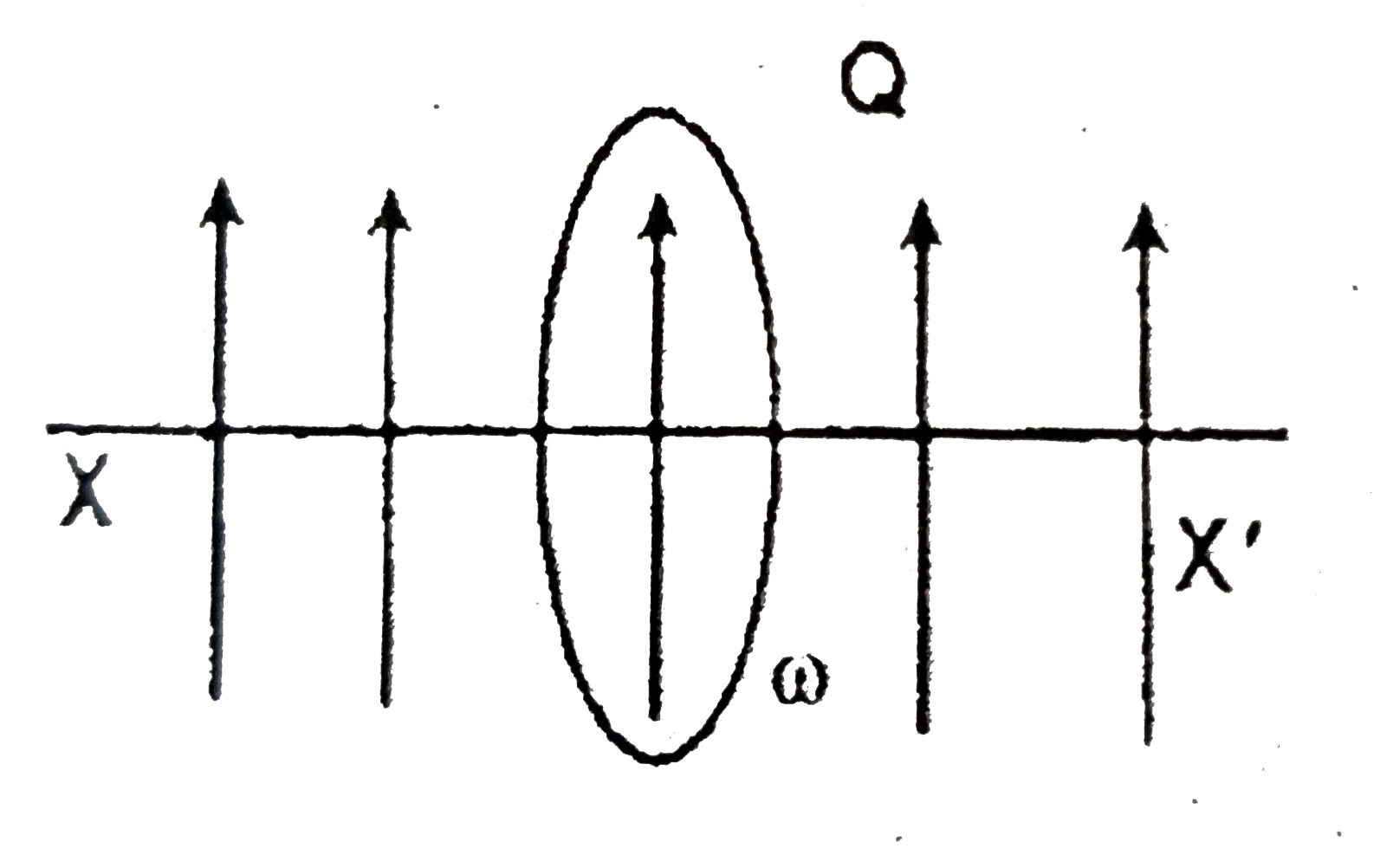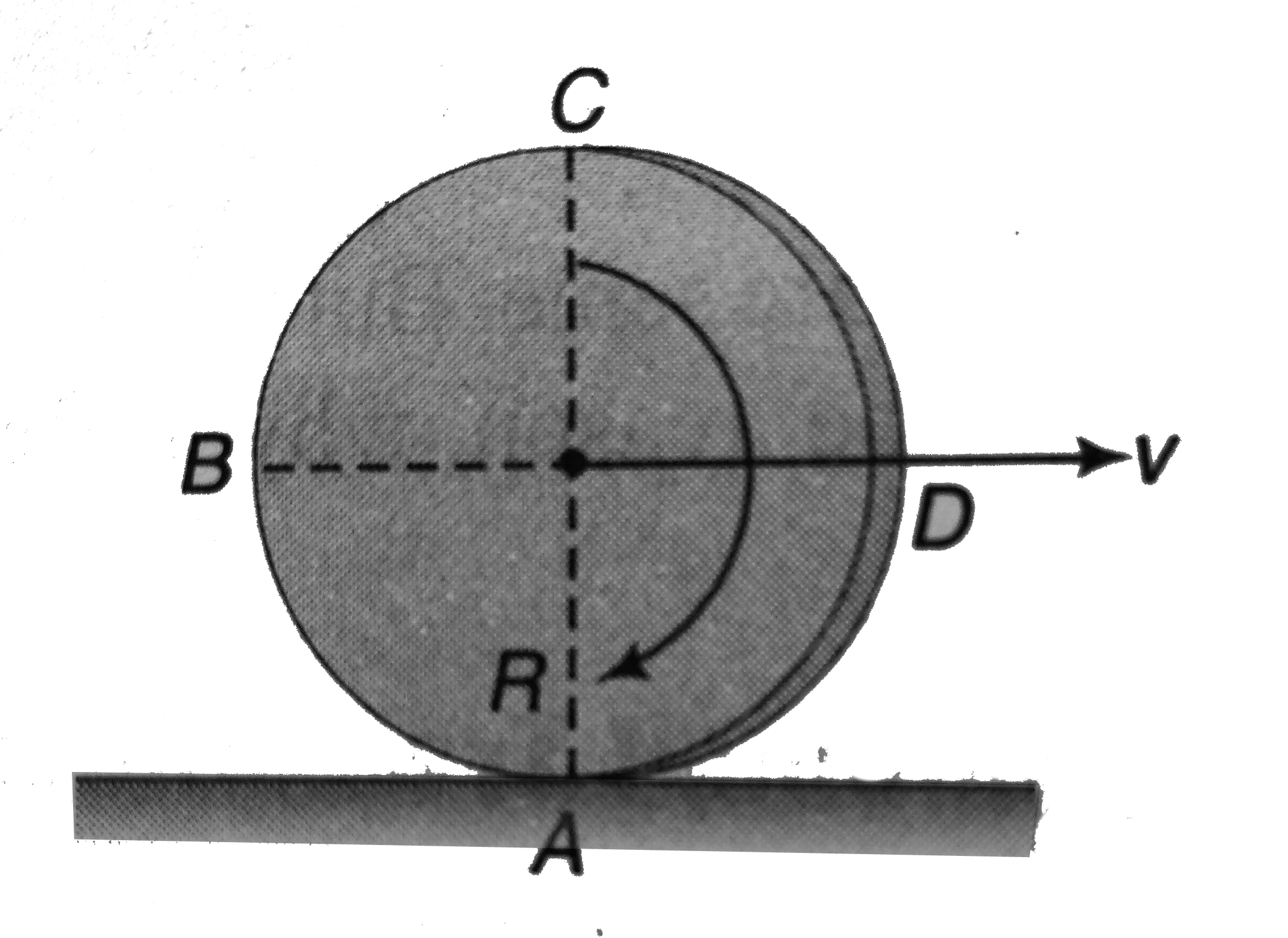Two discs A and B are mounted coaxially ona vertical axle. The discs have moments of inertia l and 2l respectively about the common axis. Disc A is imparted an initial angular velocity 2ω using the centre potential energy of a spring compressed by a distance x1. Disc B is imparted angular velocity ω by a spring having the same spring constant and compressed by a distance x2. Both the disc rotate in the clockwise direction.
The loss of kinetic energy the above process is -
Iω32
Iω23
Iω24
Iω26
The correct Answer is:B
To solve the problem of finding the loss of kinetic energy when two discs A and B are brought into contact, we can follow these steps:
Step 1: Determine the initial kinetic energies of the discs
1. Disc A has a moment of inertia IA=I and an initial angular velocity ωA=2ω.
- The kinetic energy KEA of disc A is given by:
KEA=12IAω2A=12I(2ω)2=12I⋅4ω2=2Iω2
2. Disc B has a moment of inertia IB=2I and an initial angular velocity ωB=ω.
- The kinetic energy KEB of disc B is given by:
KEB=12IBω2B=12(2I)ω2=Iω2
3. Total initial kinetic energy KEinitial is:
KEinitial=KEA+KEB=2Iω2+Iω2=3Iω2
Step 2: Calculate the final angular velocity when the discs are brought into contact
Using the conservation of angular momentum:
IAωA+IBωB=(IA+IB)ωfinal
Substituting the values:
I⋅(2ω)+2I⋅ω=(I+2I)ωfinal
This simplifies to:
2Iω+2Iω=3Iωfinal
4Iω=3Iωfinal
Dividing both sides by 3I:
ωfinal=4ω3
Step 3: Determine the final kinetic energy of the system
1. The total moment of inertia when both discs are rotating together is:
Itotal=IA+IB=I+2I=3I
2. The final kinetic energy KEfinal is:
KEfinal=12Itotalω2final=12(3I)(4ω3)2
Simplifying this:
KEfinal=12(3I)⋅16ω29=48Iω218=8Iω23
Step 4: Calculate the loss of kinetic energy
The loss of kinetic energy ΔKE is given by:
ΔKE=KEinitial−KEfinal
Substituting the values:
ΔKE=3Iω2−8Iω23
Finding a common denominator:
ΔKE=9Iω23−8Iω23=Iω23
Final Answer
The loss of kinetic energy in the above process is:
ΔKE=Iω23
- The kinetic energy KEA of disc A is given by:
KEA=12IAω2A=12I(2ω)2=12I⋅4ω2=2Iω2
- The kinetic energy KEB of disc B is given by:
KEB=12IBω2B=12(2I)ω2=Iω2
KEinitial=KEA+KEB=2Iω2+Iω2=3Iω2
IAωA+IBωB=(IA+IB)ωfinal
Substituting the values:
I⋅(2ω)+2I⋅ω=(I+2I)ωfinal
This simplifies to:
2Iω+2Iω=3Iωfinal
4Iω=3Iωfinal
Dividing both sides by 3I:
ωfinal=4ω3
Itotal=IA+IB=I+2I=3I
KEfinal=12Itotalω2final=12(3I)(4ω3)2
Simplifying this:
KEfinal=12(3I)⋅16ω29=48Iω218=8Iω23
ΔKE=KEinitial−KEfinal
Substituting the values:
ΔKE=3Iω2−8Iω23
Finding a common denominator:
ΔKE=9Iω23−8Iω23=Iω23
ΔKE=Iω23
Topper's Solved these Questions
- RIGID BODY DYNAMICS 2BOOK - CENGAGE PHYSICS ENGLISHCHAPTER - RIGID BODY DYNAMICS 2EXERCISE - Interger
2 Videos
- RIGID BODY DYNAMICS 2BOOK - CENGAGE PHYSICS ENGLISHCHAPTER - RIGID BODY DYNAMICS 2EXERCISE - AR_TYPE
2 Videos
- RIGID BODY DYNAMICS 1BOOK - CENGAGE PHYSICS ENGLISHCHAPTER - RIGID BODY DYNAMICS 1EXERCISE - Integer
11 Videos
- SOUND WAVES AND DOPPLER EFFECTBOOK - CENGAGE PHYSICS ENGLISHCHAPTER - SOUND WAVES AND DOPPLER EFFECTEXERCISE - Integer
16 Videos
Similar Questions
Two discs A and B are mounted co-axially one vertical axle. The discs have moments of inertia l and 2l respectively about the common axis. Disc A is imparted an initial angular velocity 2ω using the centre potential energy of a spring compressed by a distance x1. Disc B is imparted angular velocity ω by a spring having the same spring constant and compressed by a distance x2. Both the disc rotate in the clockwise direction.
The rotation x1/x2 is.
View SolutionTwo discs A and B are mounted coaxiallay on a vertical axle. The discs have moments of inertia I and 2 I respectively about the common axis. Disc A is imparted an initial angular velocity 2ω using the entire potential energy of a spring compressed by a distance x1 Disc B is imparted an angular velocity ω by a spring having the same spring constant and compressed by a distance x2 Both the discs rotate in the clockwise direction.
When disc B is brought in contact with disc A, they acquire a common angular velocity in time t. The average frictional torque on one disc by the other during this period is
View SolutionA disc is rotating with angular velocity ω. If a child sits on it, what is conserved?
View SolutionA disc of mass m has a charge Q distributed on its surface. It is rotating about an XX' with a angular velocity ω. The force acting on the disc is

View Solution
A disc of radius R has linear velocity v and angular velocity ω as shown in the figure. Given υ=rω find velocity of point A, B, C and D on the disc.
View SolutionTwo discs are mounted on frictionless bearings on a common shaft. The first disc has rotational inertia / and is spinning with angular velocity ω. The second disc has rotational inertia 2/ and is spinning in opposite direction with angular velocity 3ω, as shown in figure. The two discs are slowly forced towards each other along the shaft until they couple and have a final common angular velocity of

View SolutionA circular disc is rotating about its own axis at an angular velocity ω. If P is exact midpoint of dise between axis and rim of disc then angular velocity of Pis
View SolutionA non-conducting disc having unifrom positive charge Q, is rotating about its axis with unifrom angular velocity ω.The magnetic field at the centre of the disc is.

View SolutionTwo discs A and B have same mass and same thickness. If d1 and d2 are the densities of the materials of the discs A and B respectively, then the ratio of the moment of inertia of the discs A and B about their geometrical axis is
View SolutionTwo discs of same moment of inertia rotating about their regular axis passing through centre and perpendicular to the plane of disc with angular velocities ω1 and ω2. They are brought into contact face to face coinciding the axis of rotation. The expression for loss of energy during this process is
View Solution